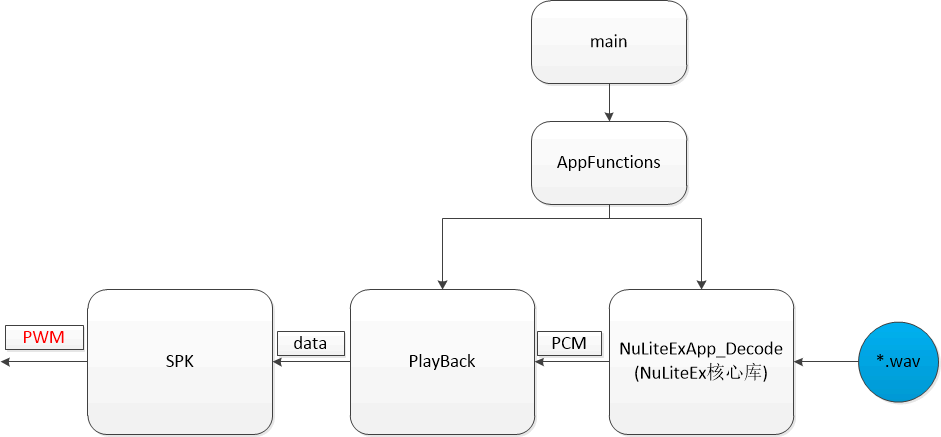ISD9160学习笔记03_ISD9160音频解码代码分析
录音例程涉及了录音和播放两大块内容,这篇笔记就先来说说播放,暂且先击破解码这部分功能。
我的锤子便签中有上个月记下的一句话,“斯蒂芬·平克说,写作之难,在于把网状思考,用树状结构,体现在线性展开的语句里。”这篇代码解析也有类似的困难,代码的网状结构,如何用文章这种线性载体来体现。我尽量挑出了主干,来讲解自己的理解。另外在文章最后添加了一个模块拓扑图来帮助消化。
我还是建议大家还是多琢磨下源码,代码的事还是让代码来说话,笔记是一个辅助的概括梳理。
本文作者twowinter,转载请注明:http://blog.csdn.net/iotisan/
查看代码主逻辑,主要是App_StartPlay和App_ProcessPlay这两个函数。下面就分别进行分析。
第一部分 App_StartPlay
BOOL App_StartPlay(void) { // Initiate NuLiteEx audio decode lib with callback functions stored in g_asAppCallBack[0] NuLiteExApp_DecodeInitiate(&g_sApp.sNuLiteExAppDecode, (UINT8 *)&g_sApp.uTempBuf, 0); // Start NuLiteEx decode lib to decode NuLiteEx file stored from address and played from audio channel 0. // And decode the first frame of PCMs. if ( NuLiteExApp_DecodeStartPlayByAddr(&g_sApp.sNuLiteExAppDecode, AUDIOROM_STORAGE_START_ADDR, 0) == FALSE ) return FALSE; // Light playback led(PB9) for display status. OUT4(0); // Start Ultraio Timer & HW pwm for UltraIO curve output ULTRAIO_START(); // Start to playback audio. Playback_StartPlay(); }
可以看到App_StartPlay主要牵扯了NuLiteExApp和Playback两部分子函数。
重中之重 NuLiteExApp_DecodeStartPlayByAddr
由于对音频编解码这块比较陌生,我还是给对应代码做了中文注解方便消化。
BOOL NuLiteExApp_DecodeStartPlayByAddr(S_NULITEEX_APP_DECODE *psNuLiteExAppDecode, UINT32 u32NuLiteExStorageStartAddr, UINT8 u8PlaybackChannel) { UINT16 u16SampleRate; // NuLiteEx解码库初始化对应的工作缓冲区,应用层传入temp缓存来方便解码库内部工作。另外根据传入的SPI地址从SPI取文件,获取采样率。 // NuLiteEx decoder initiates work buffer and returns sample rate. if ( (u16SampleRate = NuLiteEx_DecodeInitiate( (UINT8*)psNuLiteExAppDecode->au32DecodeWorkBuf, psNuLiteExAppDecode->pau8TempBuf, u32NuLiteExStorageStartAddr, g_asAppCallBack[psNuLiteExAppDecode->u8CallbackIndex].pfnReadDataCallback )) == 0 ) return FALSE; // 给Playback模块对接对应的工作缓冲区,方便其下一步播放。 // Initiate and set output buffer variable(include frame size, buffer size etc.) Playback_SetOutputBuf( &psNuLiteExAppDecode->sOutBufCtrl, NULITEEXAPP_OUT_BUF_SIZE, psNuLiteExAppDecode->i16OutBuf, NULITEEXAPP_OUT_SAMPLES_PER_FRAME, u16SampleRate ); // 工作缓冲区,置有效位。 // Trigger active flag of output buffer for NuLiteEx decoding BUF_CTRL_SET_ACTIVE(&psNuLiteExAppDecode->sOutBufCtrl); // 工作缓冲区中的读写指针赋值。 // Pre-decode one frame psNuLiteExAppDecode->sOutBufCtrl.u16BufWriteIdx = NULITEEXAPP_OUT_SAMPLES_PER_FRAME; if ( NuLiteExApp_DecodeProcess(psNuLiteExAppDecode) == FALSE ) { BUF_CTRL_SET_INACTIVE(&psNuLiteExAppDecode->sOutBufCtrl); return FALSE; } psNuLiteExAppDecode->sOutBufCtrl.u16BufReadIdx = NULITEEXAPP_OUT_SAMPLES_PER_FRAME; // 记录当前播放的channel,用来停止播放。 // Record play channel index for stopping to play. psNuLiteExAppDecode->u8PlaybackChannel = u8PlaybackChannel; // 准备播放,把这里的循环缓冲区同playback共用。 // Add audio codec into channel and preper to play codec. Playback_Add(psNuLiteExAppDecode->u8PlaybackChannel, &psNuLiteExAppDecode->sOutBufCtrl); return TRUE; }
也很重要的Playback_StartPlay
void Playback_StartPlay(void) { INT16 *pi16PcmBuf; if( s_u8PlayCtrl == PLAYBACK_NOACTION ) // 这个s_u8PlayCtrl是playback模块内部处理的。 { #if ( PLAYBACK_CHANNEL_COUNT > 1) pi16PcmBuf = g_ai16DACSamples; #else pi16PcmBuf = &g_psDacBufCtrl->pi16Buf[g_psDacBufCtrl->u16BufReadIdx];// PCM数据缓冲区复制。 #endif #if ((APU_FILTER_ENABLE == 1)&&(APU_UPSAMPLE == 2)) NuDACFilterEx_Up2Initial(g_au8Up2WorkBuf); #elif ((APU_FILTER_ENABLE == 1)&&(APU_UPSAMPLE == 4)) NuDACFilterEx_Up4Initial(g_au8Up4WorkBuf); #endif g_u8AppCtrl|=APPCTRL_PLAY; s_u8PlayCtrl |= PLAYBACK_START; #if (APU_ENABLE) { UINT8 u8Count; for( u8Count = 0; u8Count < 8; u8Count ++) g_ai16DACSamples[u8Count] = 0; //Clear virtual buffer } #endif Playback_ResetChannelVolume(0); SPK_Start(); // 这里头开始调用DPWM来播放DPWM->DATA,DPWM_START_PLAY(DPWM); #if (APU_PDMA_ENABLE) PdmaCtrl_Start(APU_PDMA_CH, (uint32_t *)pi16PcmBuf, (uint32_t *)&DPWM->DATA, 8);// 将PCM缓冲数据传到DPWM->DATA中。 #endif } }
第二部分 App_ProcessPlay
App_ProcessPlay只调用了如下这个函数
BOOL NuLiteExApp_DecodeProcess(S_NULITEEX_APP_DECODE *psNuLiteExAppDecode) { INT16 *pi16OutBuf; // 环形缓冲区非激活状态,这个只有在应用层置位(按键停止、或者启动失败等情况) if (BUF_CTRL_IS_INACTIVE(&psNuLiteExAppDecode->sOutBufCtrl)) return FALSE; // 环形缓冲区还有未读数据 if ( Playback_NeedUpdateOutputBuf(&psNuLiteExAppDecode->sOutBufCtrl) ) { // 由核心库来判断这个文件是否解析完了 // Check end of file if(NuLiteEx_DecodeIsEnd((UINT8*)psNuLiteExAppDecode->au32DecodeWorkBuf)) { // Trigger inactive flag of output buffer to stop NuLiteEx decoding BUF_CTRL_SET_INACTIVE(&psNuLiteExAppDecode->sOutBufCtrl); // Use to represnt no active(or end) of decoding psNuLiteExAppDecode->sOutBufCtrl.u16SampleRate = 0; return FALSE; } // Record output data buffer pointer(for duplicate & process) pi16OutBuf = (PINT16)&psNuLiteExAppDecode->sOutBufCtrl.pi16Buf[psNuLiteExAppDecode->sOutBufCtrl.u16BufWriteIdx]; // 核心库继续发挥其巨大作用,开足马力读取文件中PCM数据转到缓冲区。 NuLiteEx_DecodeProcess( (UINT8*)psNuLiteExAppDecode->au32DecodeWorkBuf, psNuLiteExAppDecode->pau8TempBuf, pi16OutBuf, g_asAppCallBack[psNuLiteExAppDecode->u8CallbackIndex].pfnReadDataCallback, g_asAppCallBack[psNuLiteExAppDecode->u8CallbackIndex].pfnUserEventCallback); // PlayBack依旧共享这个缓冲区,准备对数据进行进一步处理 // Update write index of output buffer and avoid buffer overflow Playback_UpdateOutputBuf(&psNuLiteExAppDecode->sOutBufCtrl); // Duplicate data into buffer for using duplication callback function. if ( psNuLiteExAppDecode->u8CtrlFlag&(NULITEEXAPP_CTRL_DUPLICATE_TO_BUF|NULITEEXAPP_CTRL_DUPLICATE_TO_FUNC) ) { if ( psNuLiteExAppDecode->u8CtrlFlag & NULITEEXAPP_CTRL_DUPLICATE_TO_BUF ) BufCtrl_WriteWithCount(psNuLiteExAppDecode->psDuplicateOutBufCtrl, NULITEEXAPP_OUT_SAMPLES_PER_FRAME, pi16OutBuf ); else psNuLiteExAppDecode->pfnDuplicateFunc(NULITEEXAPP_OUT_SAMPLES_PER_FRAME, pi16OutBuf); } } return TRUE; }
总结
源码拓扑结构






